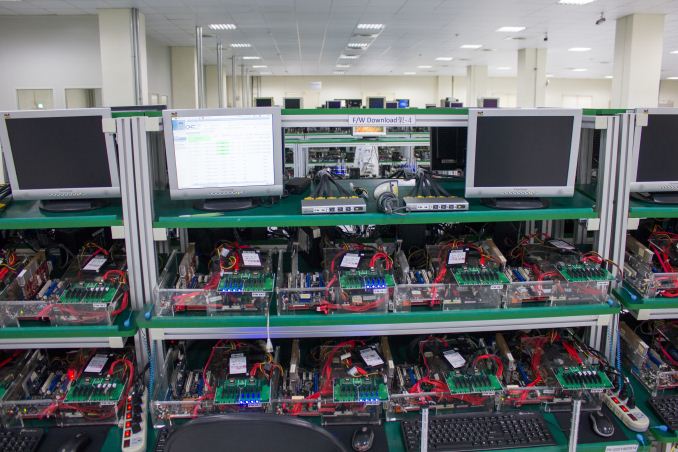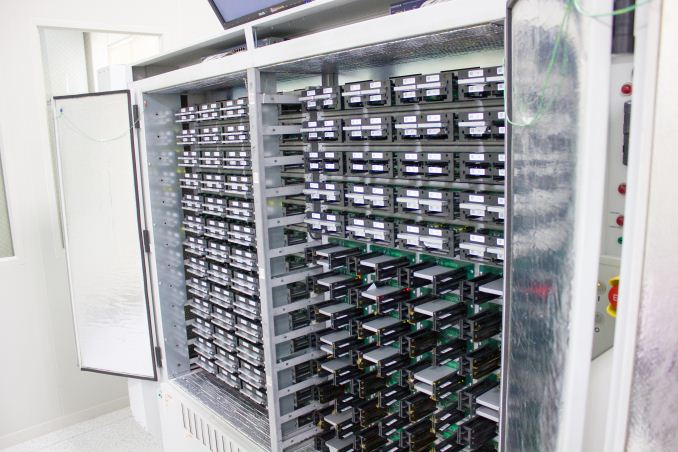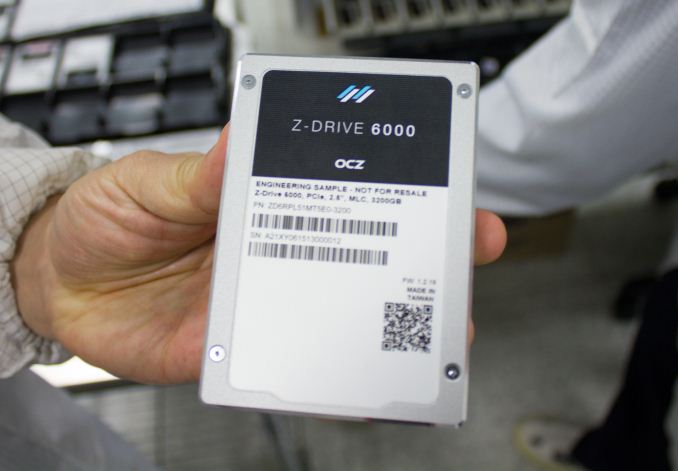Inside OCZ's Factory: How SSDs Are Made
by Kristian Vättö on May 20, 2015 8:30 AM ESTFirmware Installation
Now that the hardware side of the drive is ready, it's time to put some intelligence (the firmware) inside.
The firmware download is done by custom PC setups that consist of normal PC hardware (if you look closely, you can see ASUS' logo on a motherboard or two) running some sort of a Linux distro with OCZ's custom firmware download tool. If you zoom into the monitor you can see that in this case the system is applying firmware to 240GB ARC100 drives.
Once the firmware has been loaded, the drives will move to run-in testing. OCZ has developed a custom script that writes and reads all LBAs eight times with the purpose of identifying bad blocks. If a drive has more bad blocks than a preset threshold allows, it will be pulled away and either fixed or destroyed. The scripts also test performance using common benchmarking tools (e.g. AS-SSD and ATTO) to ensure that all drives meet the spec.
Currently OCZ has two different test setups. One half of the test systems are regular PCs that are very similar to the firmware download systems, whereas the other half are custom racks pictured above. OCZ is looking to move all testing to rack-based cabins since one cabin can simultaneously test 256 drives, which is far more efficient than having dozens of PC setups around that can only test a handful of drives each at a time. The test regime is the same in both cases, so it's purely a matter of space and labor efficiency.
At the moment SATA based drives are tested through the host, which means that the IO commands are sent by the host similar to how we test SSDs. For PCIe drives, however, OCZ is developing a Manufacturing Self Test (MST) that is essentially a custom firmware that is loaded into the drive, which then reads and writes all LBAs to test for bad blocks. The benefit of MST is the fact that it bypasses the host interface (i.e. all IO commands are generated by the controller/firmware), making the test cycle faster as the host overhead is removed.
Additionally, every month a sample of finished drives go through a more rigid tests called Ongoing Reliability Testing (ORT) to ensure that nothing has changed in production quality. The tests consist of Thermal Cycle Test (TCT) where the drive is subjected to thermal shocks to validate the quality of manufacturing and Reliability Demonstration Test (RDT) where drives are tested at elevated temperature (~70°C) to demonstrate that the mean time before failure (MTBF) meets the specification.
The run-in testing hasn't changed much since Toshiba took over, but Toshiba did help OCZ to align to its quality standards. All the processes running today have been inspected by Toshiba and meet the strict standards set by the company. Note that the purpose of run-in testing isn't to screen for firmware bugs, but to ensure that the hardware is functional. The firmware development and validation is done before the mass production begins and after Toshiba took over OCZ has modified its development process to increase the quality and reliability of its products.
OCZ's whole philosophy has actually changed since the previous CEO left the company because in the past OCZ always tried to be the first to the market at any cost and tried to cover every possible micro-niche, which resulted in too many product lines for the resources OCZ had. Nowadays OCZ is putting a lot of effort into product qualification and it no longer has a dozen products in development at the same time, meaning that there's now sufficient resources to properly validate every product before it enters mass production.
The run-in testing may seem light with only eight full LBA read/write spans, but honestly I don't think it's necessary to hammer a drive for days because any apparent hardware flaw should surface very quickly. Basically, the hardware either works or it doesn't, and once the drive leaves the factory it's more likely to fail due to firmware anomaly than a physical hardware failure.













64 Comments
View All Comments
Pessimism - Thursday, May 21, 2015 - link
Disappointing that marketing weighs so heavily into their design process.Refuge - Thursday, May 21, 2015 - link
Thats how it is everywhere.ryanmt - Thursday, May 21, 2015 - link
"and has been achieved through science, but there's also trial and error in the mix. "What exactly to you think 'science' is?
ArmedandDangerous - Thursday, May 21, 2015 - link
Very informative, but I have to say, the writing style and quality feels like a regular blogger putting up posts on a blog. It didn't have the usual insights and technological knowledge of a Anand writer. Waiting for more works from you Kristian, and keep on improving :)Slappi - Friday, May 22, 2015 - link
Ralph Schmitt should be thrown in jail along with OCZ's former CEO who robbed shareholders of hundreds of millions of dollars. I wouldn't buy an OCZ drive if it was the fastest drive on the planet.Oxford Guy - Friday, May 22, 2015 - link
Who doesn't like a little bait and switch? Send out Vertex 2 drives with 32-bit NAND then sell drives with half the NAND chips to consumers. Whoops!Then come up with a "voluntary replacement plan" that doesn't apply to the expensive (at the time) 240 GB model. And, top it all off with spectacularly buggy drives — drives that are basically ticking time bombs waiting to brick when the user does something weird like put their laptop to sleep.
Ethos Evoss - Sunday, May 24, 2015 - link
Jeeezus picked up worst company ..Richard Buyme - Sunday, May 24, 2015 - link
Good ole' oczSame as the original ocz.safeshopper.com that conned and scammed end users when they were a reseller courtesy of Ryan Petersen
Sadly, time heals all wounds it would seem, even on the internet. Who knows how many thousands of dollars this corporation reamed out of customers' wallets back in the day (circa 2000-2001), orders taken but not shipped.
This article details some of what OCZ's founder was like before he abruptly resigned without comment in 2012
http://seekingalpha.com/instablog/890075-copperfie...
hirschma - Monday, May 25, 2015 - link
The article isn't quite correct in some areas.The first part of the process is called "stencil printing". A thin, stainless stencil is used in a stencil printer (more or less a robotic squeegee) to apply solder paste to the board. There are no sockets - the paste is applied directly to the pads.
Solder paste does not spoil after two hours; while it is temperature sensitive, it isn't that sensitive. It probably takes over two hours for a jar that size (.5 kg) to come up to room temps.
Although it isn't mentioned, I'd expect an outfit like this to do a paste inspection before the pick and place machine places the components.
Lastly, the choice of using through-hole, hand soldered SATA connectors is odd. There's no reason why they couldn't use surface mount just as easily (although through-hole is going to withstand more abuse).
hirschma - Monday, May 25, 2015 - link
Heh, took another look.If they're doing things "according to hoyle", there should be an X-Ray inspection for BTCs - bottom terminated chips. Just because a board works, doesn't mean that it'll continue to do so if there are certain defects that can only be caught that way.
Also - strangely - they do appear to be using surface mount connectors, but why they put them on in a separate process (if I read the article correctly) is very strange. Might have something to do with the testing - they may do an initial test before singulation (removing the individual boards), and then only put the connects on if it passes (the connectors are probably more expensive than the labor).
Last comment - not sure why they're using such small panels (i.e., only 4up). The standard in China is a square meter - likely due to the the contract manufacturer having equipment that can only handle smaller panels.